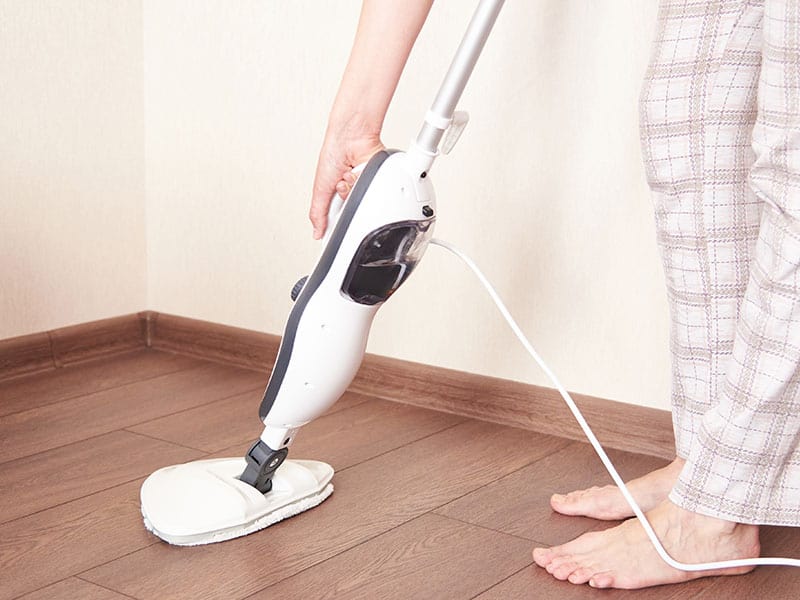Imagine this: You’ve just finished a long day and finally have time to relax. But first, you need to tackle the never-ending chore of cleaning your floors. You reach for your trusty steam mop, eager to tackle grime and bacteria with its powerful steam. But then, a nagging doubt creeps in: “Is this actually good for my vinyl flooring?”

Image: www.lightstickhooverreview.com
This is a question that plagues many homeowners, and for good reason. Vinyl floors are a popular choice for their durability and affordability, but they’re also sensitive to heat. So, is the intense heat of a steam mop a friend or foe to your vinyl floors? Let’s dive into the world of steam mopping and vinyl floors to find out.
Understanding the Potential Risks of Steam Mops on Vinyl Flooring
Steam mops are known for their ability to sanitize and deep clean floors. They work by heating water to create steam, which loosens dirt and debris, making it easier to wipe away. However, this potent steam can also pose a risk to your vinyl floors if not used correctly.
Here’s why:
- Vinyl flooring is sensitive to heat. While vinyl is a durable material, it can warp or buckle under extreme heat. Steam mops, with their scorching temperatures, can potentially cause damage if used incorrectly or for extended periods.
- Improper steam mop technique can lead to warping. Using too much steam, leaving the steam mop in one place for too long, or failing to dry the floors thoroughly after steaming can contribute to warping or bubbling.
- Steam can damage the vinyl’s finish. The high heat from steam mops can also affect the top layer of vinyl, dulling its shine and making it more susceptible to scratches and damage.
When is a Steam Mop Safe for Vinyl Floors?
Just because using a steam mop on your vinyl floors poses potential risks doesn’t mean it’s always a no-go. By taking certain precautions and using common sense, you can use a steam mop to achieve sparkling floors without compromising the integrity of your vinyl.
Here’s how to use a steam mop safely on vinyl flooring:
- Check your floor’s instructions: Before you even think about steam mopping, consult your manufacturer’s instructions. Some vinyl floors are explicitly designed for steam mopping, while others may have limitations or restrictions.
- Use a low-heat setting: If your vinyl floor is compatible with steam cleaning, always use a low-heat setting. This helps minimize the risk of warping or damage.
- Avoid prolonged contact: Don’t leave the steam mop in one place for too long. This prevents the build-up of excessive heat on the surface. Instead, use light, sweeping motions and move on quickly.
- Dry your floors thoroughly: After steam mopping, ensure you wipe down the floors with a dry cloth to remove traces of moisture. This minimizes the risk of warping or attracting dust and dirt.
- Consider a steam mop with adjustable steam settings: Some steam mops feature adjustable steam settings, allowing you to control the temperature and intensity of the steam. This gives you more flexibility in cleaning different types of floors, including vinyl.
- Test in a hidden area: Always test the steam mop on a small, inconspicuous area of your vinyl flooring before tackling the entire floor. This helps you assess your floor’s reaction to the steam and prevent any unforeseen damage.
Alternatives to Steam Mops for Vinyl Floors
If you’re still wary of using a steam mop on your vinyl floors, there are plenty of effective cleaning methods available. Here are a few alternatives:
- Traditional mopping: While perhaps not as glamorous as steam mopping, traditional mopping with a damp mop and mild cleaning solution can be a gentle and effective way to clean vinyl floors.
- Microfiber cloths: Microfiber cloths are excellent for picking up dirt and debris, especially when paired with a cleaning solution specifically designed for vinyl floors. Using a damp microfiber cloth can effectively clean your vinyl floors without the risk of heat damage.
- Vacuuming: Vacuuming regularly can help keep your vinyl floors clean and free of dirt and debris, minimizing the need for wet cleaning.
- Sweep with a broom: For daily cleaning, a simple broom sweep can keep your vinyl floors free of loose debris and dust, preventing the build-up of dirt that can get ground into the surface.

Image: www.mtoclean.com
Expert Insights on Safe Steam Mopping
We reached out to several flooring specialists for their expert opinions on steam mopping vinyl floors. The consensus was clear:
- Read the manufacturer’s instructions: Always consult your vinyl floor manufacturer’s recommendations for cleaning. Their instructions will provide the most accurate and reliable guidance for maintaining your specific flooring.
- Lower is better: If the manufacturer allows steam mopping, choose the lowest heat setting possible, and never leave the steam mop on any one spot for too long.
- Err on the side of caution: If you’re unsure about steam mopping your vinyl floors, it’s always better to err on the side of caution and choose an alternative cleaning method.
Are Steam Mops Bad For Vinyl Floors
Conclusion
Steam mopping vinyl floors can be a great way to deep clean and sanitize your floors, but it’s essential to do so with care. By understanding the potential risks and following proper techniques, you can use a steam mop safely and effectively on your vinyl floors. However, if you’re ever unsure, always consult your flooring manufacturer’s instructions or choose a gentle alternative cleaning method.
Remember, the key is to choose a cleaning method that effectively removes dirt and grime without compromising the beauty and longevity of your vinyl floors. Now, go forth and enjoy your sparkling floors!






